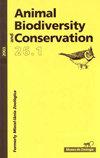A global review of animal translocation programs
IF 1
4区 环境科学与生态学
Q3 BIODIVERSITY CONSERVATION
引用次数: 28
Abstract
We performed a bibliometric analysis to investigate the efficiency of release techniques (soft and hard–release), to analyse the characteristics and outcomes of the translocation programs, to identify knowledge gaps, and to provide recommendations. Animal conservation studies involving animal release to the wild increased significantly over the 31 years studied and were more frequently performed with terrestrial mammals than with other taxonomic groups. Most of the studies were performed by researchers from developed countries. Translocations occurred mostly in temperate regions, with almost no translocations occurring in the tropics. Almost 60 % of the studies did not provide information regarding the success or failure of the translocation programs. The most commonly used technique was hard release. Wild–caught specimens were preferred for translocations. Translocation programs were less common for groups like amphibians, fishes, and invertebrates. If criteria for suitable translocation are met, this management tool should also be conducted for tropical threatened species, led by native researchers. Furthermore, criteria for successful translocation should be clearly identified in order to improve future conservation actions.动物易位项目的全球综述
我们进行了文献计量学分析,以调查释放技术(软释放和硬释放)的效率,分析易位程序的特征和结果,确定知识差距,并提供建议。在研究的31年中,涉及动物放归野外的动物保护研究显著增加,并且陆生哺乳动物比其他分类类群更频繁地进行。大多数研究是由发达国家的研究人员进行的。易位主要发生在温带地区,热带地区几乎没有易位。几乎60%的研究没有提供关于移植项目成功或失败的信息。最常用的手法是硬松。野生捕获的标本更适合易位。易位程序在两栖动物、鱼类和无脊椎动物等群体中不太常见。如果符合适当迁移的标准,这种管理工具也应该在当地研究人员的领导下对热带濒危物种进行管理。此外,应该明确确定成功迁移的标准,以改善未来的保护行动。
本文章由计算机程序翻译,如有差异,请以英文原文为准。
求助全文
约1分钟内获得全文
求助全文
来源期刊

Animal Biodiversity and Conservation
农林科学-动物学
CiteScore
2.00
自引率
0.00%
发文量
21
审稿时长
>12 weeks
期刊介绍:
Animal Biodiversity and Conservation (antes Miscel·lània Zoològica) es una revista interdisciplinar, publicada desde 1958 por el Museu de Ciències Naturals de Barcelona. Incluye artículos de investigación empírica y teórica en todas las áreas de la zoología (sistemática, taxonomía, morfología, biogeografía, ecología, etología, fisiología y genética) procedentes de todas las regiones del mundo. La revista presta especial interés a los estudios que planteen un problema nuevo o introduzcan un tema nuevo, con hipòtesis y prediccions claras, y a los trabajos que de una manera u otra tengan relevancia en la biología de la conservación. No se publicaran artículos puramente descriptivos, o artículos faunísticos o corológicos en los que se describa la distribución en el espacio o en el tiempo de los organismes zoológicos.
 求助内容:
求助内容: 应助结果提醒方式:
应助结果提醒方式:


